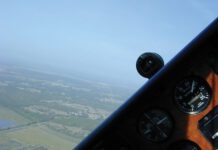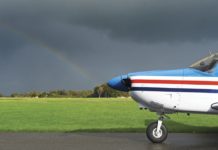Light twin flying and rattlesnake encounters start without much drama, certainly, but with carelessness and a casual attitude about the possible end results. Theyre rigged against untrained and unwary people, however, and the results are often the same.
Twin-engine airplanes demand a healthy respect from those who fly them. Some of that must come from the improved performance when everything is working right, and some must come from the slim margins for error that exist when something goes wrong.
Once upon a time, back in 1979, things were booming in general aviation circles. Sales of light piston twins had been increasing by leaps and bounds for a decade. The popular reasoning of the time was that two engines bolted onto an airframe were a lot better than one. If one engine failed on a single, that was it. But if one engine failed on a twin, just proceed on to the nearest airport of your choice, land and get the malfunction repaired. In addition, there were benefits of speed and altitude to be had from twins.
The NTSB, keeping score on the sidelines, knew better by 1979. First, statistics clearly showed that pilots were poorly prepared to meet an engine failure on a piston twin in critical phases of flight, especially takeoff and climb. One NTSB study examined 2,229 accidents, of which 610 involved fatalities. Engine failures were involved in 123 of the fatal accidents. The pilots had lost control of their aircraft, after the engines (one failed and the other operating) developed an unbalanced thrust condition that overwhelmed the pilot.
The study concluded that if you experienced an engine failure in a light twin, the chance of someone dying was four times as high as during an engine failure in a single. The evidence was clear: The single-engine performance of a light piston twin wasnt much to rely on.
With an engine failure in a single-engine aircraft, you simply maintain a safe glide speed and make an emergency landing. But an engine failure in a twin will change its flight characteristics in a split second. The advertisements used to say – and pilots believed – that performance was only down 50 percent when an engine failed. The fact is, performance drops 80 percent or more. And this is what almost all of the training in light piston twins is about. It can be done, but it takes careful handling and excellent training.
The Goals of Training
The NTSB study put a big dent in the belief that multi-engine flying was much safer than plugging along with just one engine out front. There were bulletins from the FAA, articles in all the flying magazines and new emphasis on the type of check rides that were given by examiners to multi-engine instructor applicants.
Despite the fact that sales of new light piston twins have all but evaporated, there are still many twins around, and they figure heavily in air freight and business flight accidents. Insurance companies may demand periodic training for the principal pilots, given by Part 141 schools, before considering offering insurance to light twin owners.
Potential multi students should understand that the multi-engine rating is serious business, and that there is really no cheap, clean, easy way to be a competent light twin pilot. Not only is a good course of instruction required, but maintaining proficiency is a never-ending task.
In January a Mitsubishi MU-2B was departing San Antonio International Airport with a commercial pilot at the controls and a pilot-rated passenger. The aircraft was fueled and rolled down runway 30L. During the initial climb, witnesses heard a banging noise and saw the right propeller stop rotating. The airplane reached about 200 feet agl, banked to the right, entered a nose-low attitude and descended into the ground. The pilot made no distress call.
Mental preparation is an important part of flying light twins. There is very little time to act when an engine fails. There are difficult choices to make and complicated procedures that must be followed exactly. Pilots need to expect and plan for an engine failure. The emergency procedures must be memorized, understood and rehearsed mentally. It is virtually impossible for a multi-engine pilot to rely on instincts when an engine fails on takeoff.
Generally speaking, light twins are faster and will carry more useful load than single-engine aircraft. If a pilot understands the basic facts of twin-engine flying and maintains skills and currency in the aircraft, light twins offer a high degree of safety. But pilots who dont meet these conditions are flying an airplane that is much less safe than almost any single-engine aircraft.
If you lose power on one engine in a light piston twin, there are two things you might do: continue the flight or prepare for a forced landing. You need to know – from the knowledge gained in previous training – which is the best choice.
The Rattlesnakes Rattle
The worst situation is usually an engine failure during liftoff or just after liftoff. The airplane is in a state where most light twins just cant climb on one engine. The airspeed indicator in light twins marks a speed with a red line on the dial face. This is Vmc – the minimum control speed. The danger zone. If an engine failure occurs at or below this airspeed, the asymmetric yaw caused by the operating engine will be more than you could overcome with the available rudder.
The Need for Speed Control
If the pilot can keep a high enough airspeed, there will be enough rudder effectiveness to stop the yawing moment. But if the airspeed is allowed to die off, the pilot is helpless to stop the yaw. The only action left is an immediate reduction of power on the engine that is operating, keeping control and landing more or less straight ahead.
If you try to remain airborne below Vmc, the airplane usually goes out of control and rolls toward the dead engine. If the wing with the dead engine stalls, you can count on entering a spin in the direction of the dead engine, possibly an inverted one. Recovery? No encouraging statistics are available.
Vmc is not a great mystery. The speed requires the other engine to be producing takeoff power, the gear up and the flaps at takeoff position. The speed is determined during certification, when the test pilot must, at Vmc, be able to stop the turn, with the dead engine windmilling, within 20 degrees of the original heading, using maximum rudder deflection, along with a maximum 5 degree bank into the operating engine. The airplane doesnt need to be able to climb or even maintain altitude. In addition, after recovery, the pilot should be able to hold the airplane in straight flight, without banking more than 5 degrees toward the operating engine.
Once the recovery is made, the pilot should try to accelerate to Vyse, the single-engine best rate of climb speed, if gaining altitude is the goal. Vyse is indicated on the airspeed indicator by a blue line. This speed will either give the pilot the maximum rate of climb, or the minimum rate of descent, depending on conditions.
Here is where the really experienced multi-engine instructor has the greatest value. A full-motion simulator can also provide much useful procedural training, but experience in the air, with various aircraft configurations and conditions, is the most valuable. Your flight instructor should thoroughly understand, and be able to demonstrate (and let you experiment with) all the various conditions of Vmc. Vmc is not a static number on the airspeed indicator that never changes; the marked value applies only to certification conditions. A good multi-engine instructor will be able to explain and demonstrate all of the Vmc/Vyse relationships.
There are many circumstances in which the red-line airspeed wont be the true Vmc. For example, if the operating engine is only developing partial power (less than takeoff power), would you believe that the Vmc will be less than published, less than red line? In addition, actual Vmc decreases with increased altitude and decreased aircraft weight.
At high altitudes, Vmc can decrease below that of stall speed. If an engine fails and the pilot lets the aircraft slow to this speed, the loss of control and a stall will occur together. This is usually followed by an unrecoverable flat spin.
If the aircraft is at a lower altitude, the first thing that a pilot will experience is loss of directional control. You can recover from that, if you havent let it go too far. Simply reduce power on the good engine, then trade some of your altitude for airspeed. Once you have Vmc (red-line) again, smoothly add the full power back to the operating engine. You can only trade altitude for airspeed if you have the altitude to trade, however. If not, the airplane must remain under control as the pilot goes to the emergency landing site straight ahead.
What a Drag
The ability of the aircraft to gain or maintain altitude is greatly influenced by drag, also. A huge amount of drag can be produced by a windmilling prop. Extended cowl flaps produce drag. You can expect a large amount of drag from the extended landing gear, on most aircraft. Extended flaps produce drag, and will pull climb performance (Vyse) down, too. The aircraft needs to be as clean as you can get it.
Air conditioning compressors, if mounted on the operating engine, use a chunk of power. What you need in a lost engine situation is best climb performance. The air conditioner will bleed away a significant amount of the much-needed thrust. If you are using a heavy amount of electrical load, reducing it can mean more thrust from the good engine. You need to be able to get maximum power from the operating engine and clean up all the drag-producing items for the best operation of your remaining engine. If you cant, you may not be able to climb or even stay airborne.
When you have finished your multi-engine training, the minimum you should understand and be able to demonstrate is, of course, outlined in the Practical Test Standards. More than that, you need to understand thoroughly the basic fundamentals of multi-engine flight, with emphasis on single engine operation. But thats only the beginning.
The best multi-engine pilots (or single-engine pilots, for that matter) dont see maintaining currency as all work. They usually see it as a challenge to be a part of an elite group – a safe, competent light twin pilot.
Also With This Article
Click here to view “Get the Most From Your Training Dollar.”
Click here to view “Counter Fit.”
Click here to view “Creating the Home Field Advantage.”
-by Raymond Leis
Raymond Leis is a CFII and ATP with more than 23,000 hours.



